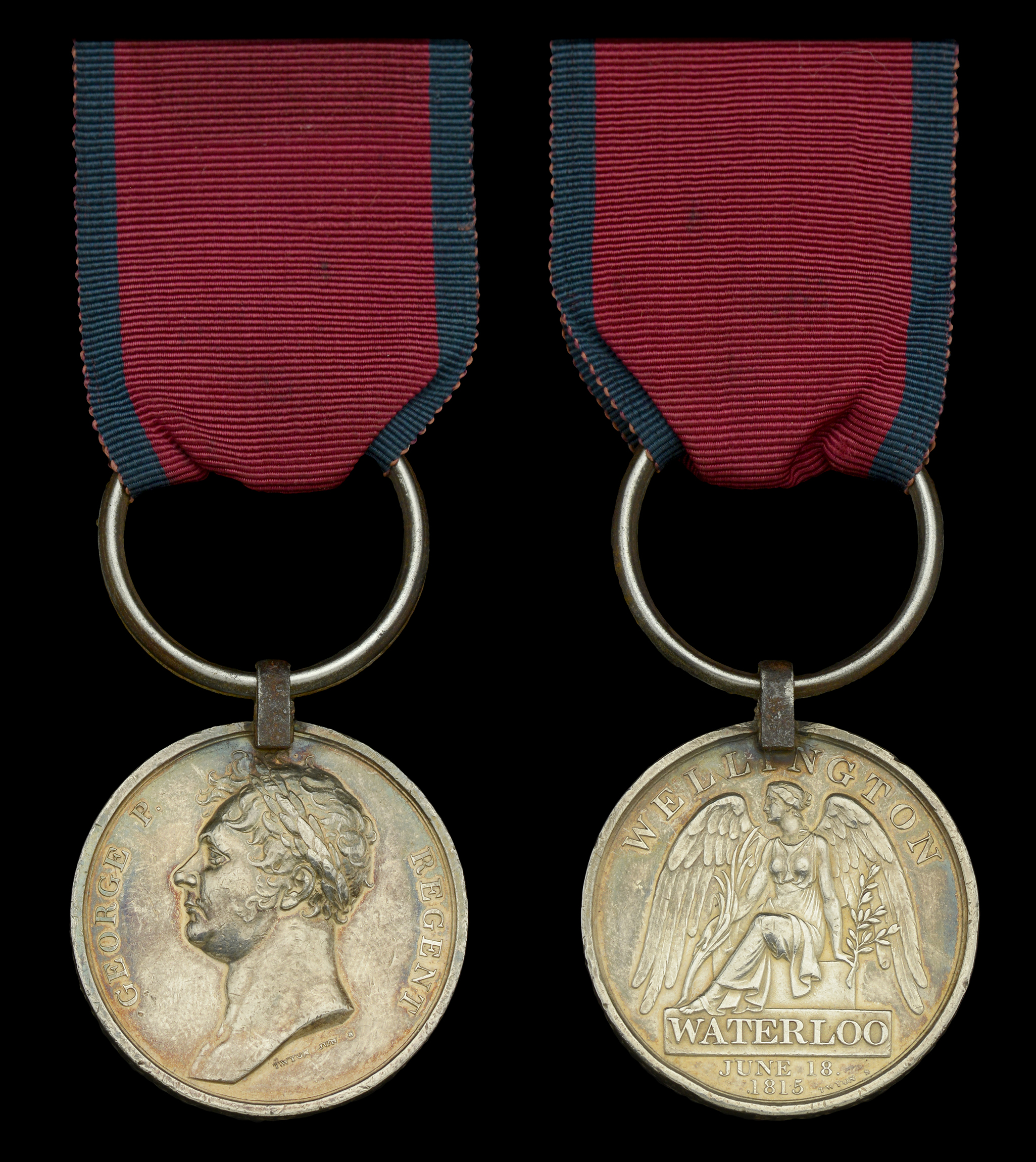214
The Waterloo medal awarded to Private James Cowell, 33rd Foot, who was taken prisoner at...
Gebote sind ohne Steuern, Aufgeld oder Versankosten.
By confirming your bid, you agree that you have read and accepted the-saleroom.com and the auctioneer's terms and conditions. Confirming your bid is a legally binding obligation to purchase and pay for the lot should your bid be successful.
Wählen Sie eine der folgenden Schnellgebotsoptionen:
Gebote sind ohne Steuern, Aufgeld oder Versankosten.
By confirming your bid, you agree that you have read and accepted the-saleroom.com and the auctioneer's terms and conditions. Confirming your bid is a legally binding obligation to purchase and pay for the lot should your bid be successful.
Waterloo 1815 (James Cowell, 33rd Regiment Foot.) fitted with replacement steel clip and ring suspension, light contact marks and edge bruising, otherwise good very fine £2,400-£2,800
---
Provenance: Day Collection 1910; Glendining’s, October 1950; Dix Noonan Webb, June 1998.
James Cowell was born in Cambridge and enlisted into the 33rd Regiment on 3 May 1812, aged 18, a labourer by trade.
The 33rd was soon off to war, the musters covering July 1813 show him being on board the Earl Moira to Rostock. By November 1813 he is aboard the Urania to Klyndarl, Holland. These moves were part of Britain's actions as part of the War of the Sixth Coalition.
In March 1814 a British force under the command of Thomas Graham, 1s Baron Lynedoch was besieging Bergen op Zoom, a port in Holland. On 8 March 1814 a British assault force seized part of the defences but a successful French counterattack forced the British to withdraw. This action resulted in casualties on the British side of 2100 killed, wounded and captured. Amongst the prisoners was James Cowell, 33rd Foot who remained a prisoner until the abdication of Napoleon on 11 April 1814. James Cowell was released in April and in May he is listed as being back with the regiment in the regimental hospital in Antwerp.
The regiment remained on the continent in Belgium, moving to various stations, Tournay, Menin and Courtray. In January 1815 he was in the regimental hospital for a short time. In March 1815, when news came of Napoleon's escape from Elba, Wellington was once again charged with overall command of the allied forces.
The 33rd was assigned to the 5th British Brigade under the command of Sir Colin Halkett together with the 2nd Battalion 30th Regiment, 2nd Battalion 69th Regiment and 2nd Battalion 73rd Regiment, the Brigade in turn forming part of Sir Charles Alten's 3rd Division. The 33rd’s first action was towards the end of the battle at Quatre Bras on the 16th June, but still managed to sustain 3 officers and 16 men killed and 7 officers and 70 men wounded.
On the 18th June the 5th Brigade was positioned to the right centre of the Allied army on some rising ground close to La Haye Sainte. The 33гd suffered, as did all the regiments from French artillery fire. It was during this time when the Duke visited Sir Colin Halket's Brigade, that Halket requested that his shattered Brigade be relieved: "Impossible" replied the Duke, "Very well my Lord, we'll stand until the last man falls.” Lieutenant Pattison of the 33rd stated they were lying down in formation to shelter from the scores of cannon balls bounding about the battlefield. At one point he helped place Lieutenant Pagan who was wounded on to a stretcher which two of his men started to carry to the rear. They had hardly left the square when a cannon ball struck one of the soldiers and carried of his leg. Assistant Surgeon Donald Finlayson of the 33rd reported that most wounds of the limbs were in the lower extremities, and that there were perhaps 7 or 8 legs taken off for every one arm.
The 33rd repelled several cavalry attacks and towards the close of the battle took part in the repulse of the Imperial Guard. The regiment sustained in action, 2 officers and 33 men killed, 8 officers and 92 men wounded. Amongst the severely wounded was James Cowell, in the right leg which was subsequently amputated. The musters list him as ‘absent wounded’ and finally sent to England on 12 December 1815, and at the General hospital at Colchester. On 21 June 1816 he was discharged to pension at Chelsea Hospital, in consequence of ‘amputated Rt. Thigh from a Wound at Waterloo’, his pension being set at 1/-a day and his intended place of residence back to Cambridge.
James Cowell died on 2 March 1858, a widower, in the Leyton Workhouse, aged 64 and listed as formerly a soldier pensioner.
Sold with copied discharge papers and other research including full muster details.
Waterloo 1815 (James Cowell, 33rd Regiment Foot.) fitted with replacement steel clip and ring suspension, light contact marks and edge bruising, otherwise good very fine £2,400-£2,800
---
Provenance: Day Collection 1910; Glendining’s, October 1950; Dix Noonan Webb, June 1998.
James Cowell was born in Cambridge and enlisted into the 33rd Regiment on 3 May 1812, aged 18, a labourer by trade.
The 33rd was soon off to war, the musters covering July 1813 show him being on board the Earl Moira to Rostock. By November 1813 he is aboard the Urania to Klyndarl, Holland. These moves were part of Britain's actions as part of the War of the Sixth Coalition.
In March 1814 a British force under the command of Thomas Graham, 1s Baron Lynedoch was besieging Bergen op Zoom, a port in Holland. On 8 March 1814 a British assault force seized part of the defences but a successful French counterattack forced the British to withdraw. This action resulted in casualties on the British side of 2100 killed, wounded and captured. Amongst the prisoners was James Cowell, 33rd Foot who remained a prisoner until the abdication of Napoleon on 11 April 1814. James Cowell was released in April and in May he is listed as being back with the regiment in the regimental hospital in Antwerp.
The regiment remained on the continent in Belgium, moving to various stations, Tournay, Menin and Courtray. In January 1815 he was in the regimental hospital for a short time. In March 1815, when news came of Napoleon's escape from Elba, Wellington was once again charged with overall command of the allied forces.
The 33rd was assigned to the 5th British Brigade under the command of Sir Colin Halkett together with the 2nd Battalion 30th Regiment, 2nd Battalion 69th Regiment and 2nd Battalion 73rd Regiment, the Brigade in turn forming part of Sir Charles Alten's 3rd Division. The 33rd’s first action was towards the end of the battle at Quatre Bras on the 16th June, but still managed to sustain 3 officers and 16 men killed and 7 officers and 70 men wounded.
On the 18th June the 5th Brigade was positioned to the right centre of the Allied army on some rising ground close to La Haye Sainte. The 33гd suffered, as did all the regiments from French artillery fire. It was during this time when the Duke visited Sir Colin Halket's Brigade, that Halket requested that his shattered Brigade be relieved: "Impossible" replied the Duke, "Very well my Lord, we'll stand until the last man falls.” Lieutenant Pattison of the 33rd stated they were lying down in formation to shelter from the scores of cannon balls bounding about the battlefield. At one point he helped place Lieutenant Pagan who was wounded on to a stretcher which two of his men started to carry to the rear. They had hardly left the square when a cannon ball struck one of the soldiers and carried of his leg. Assistant Surgeon Donald Finlayson of the 33rd reported that most wounds of the limbs were in the lower extremities, and that there were perhaps 7 or 8 legs taken off for every one arm.
The 33rd repelled several cavalry attacks and towards the close of the battle took part in the repulse of the Imperial Guard. The regiment sustained in action, 2 officers and 33 men killed, 8 officers and 92 men wounded. Amongst the severely wounded was James Cowell, in the right leg which was subsequently amputated. The musters list him as ‘absent wounded’ and finally sent to England on 12 December 1815, and at the General hospital at Colchester. On 21 June 1816 he was discharged to pension at Chelsea Hospital, in consequence of ‘amputated Rt. Thigh from a Wound at Waterloo’, his pension being set at 1/-a day and his intended place of residence back to Cambridge.
James Cowell died on 2 March 1858, a widower, in the Leyton Workhouse, aged 64 and listed as formerly a soldier pensioner.
Sold with copied discharge papers and other research including full muster details.
Orders, Decorations, Medals and Militaria
Auktionsdatum
Ort der Versteigerung
Generelle Versandinformationen vom Auktionshaus verfügbar
If you are successful in purchasing lot/s being auctioned by us and opt for the item/s to be sent to you, we will use the following methods of shipment:
Within the UK
If you live within the UK, items will be despatched using Royal Mail Special Delivery. This service provides parcel tracking (via the Royal Mail website) and next weekday delivery (betwen 9am and 1pm). Items delivered within the UK are covered by our insurance company. Heavy and bulky lots will be sent by courier, in discussion with the client.
Outside of the UK
If the item/s being sent are worth under £1000 in total they are sent using Royal Mail’s Signed For International service. This ensures the item must be signed for when it is delivered.
If the item/s being sent are valued at over £1000 in total they will be sent using FedEx. This service allows next day delivery to customers in many parts of the US and parcels are fully trackable using the FedEx website.
Shipping Exceptions
Certain lots such as those containing glass or sharp implements, etc., may not be suitable for in-house shipping within or outside of the UK. Please contact Noonans with any queries.
Wichtige Informationen
Auctioneer's Buyers Premium: 24% (+VAT)
There is an additional charge of 4.95% (+VAT/sales tax)










